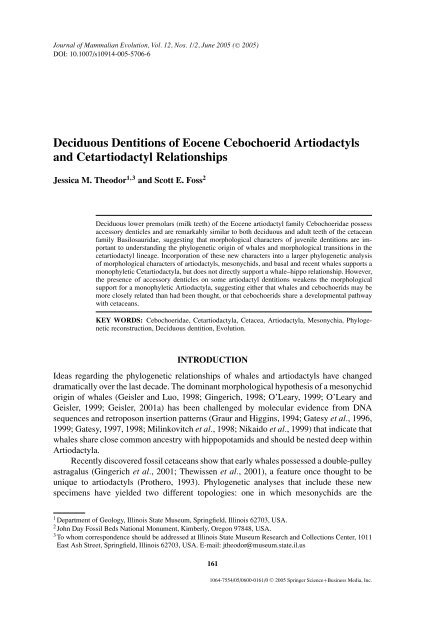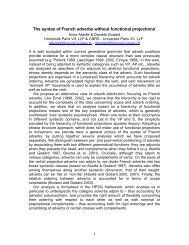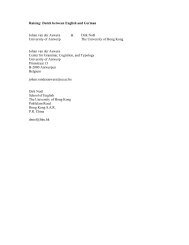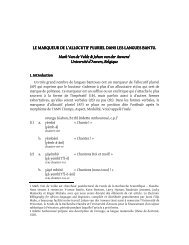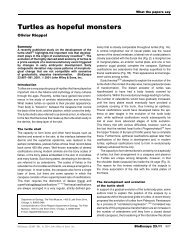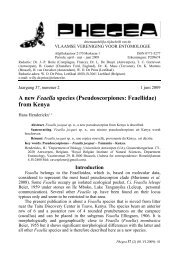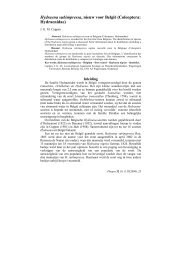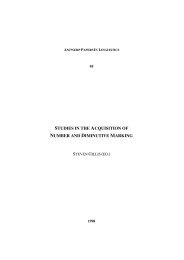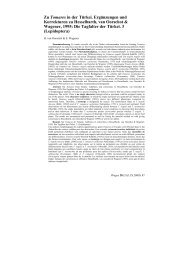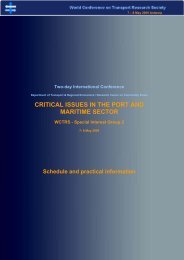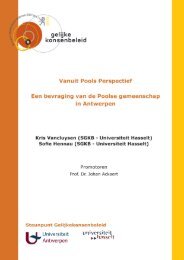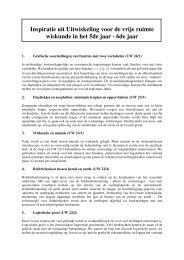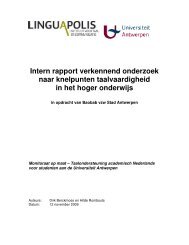Theodor2005.pdf
Theodor2005.pdf
Theodor2005.pdf
Create successful ePaper yourself
Turn your PDF publications into a flip-book with our unique Google optimized e-Paper software.
Journal of Mammalian Evolution, Vol. 12, Nos. 1/2, June 2005 ( C○ 2005)<br />
DOI: 10.1007/s10914-005-5706-6<br />
Deciduous Dentitions of Eocene Cebochoerid Artiodactyls<br />
and Cetartiodactyl Relationships<br />
Jessica M. Theodor 1,3 and Scott E. Foss 2<br />
Deciduous lower premolars (milk teeth) of the Eocene artiodactyl family Cebochoeridae possess<br />
accessory denticles and are remarkably similar to both deciduous and adult teeth of the cetacean<br />
family Basilosauridae, suggesting that morphological characters of juvenile dentitions are important<br />
to understanding the phylogenetic origin of whales and morphological transitions in the<br />
cetartiodactyl lineage. Incorporation of these new characters into a larger phylogenetic analysis<br />
of morphological characters of artiodactyls, mesonychids, and basal and recent whales supports a<br />
monophyletic Cetartiodactyla, but does not directly support a whale–hippo relationship. However,<br />
the presence of accessory denticles on some artiodactyl dentitions weakens the morphological<br />
support for a monophyletic Artiodactyla, suggesting either that whales and cebochoerids may be<br />
more closely related than had been thought, or that cebochoerids share a developmental pathway<br />
with cetaceans.<br />
KEY WORDS: Cebochoeridae, Cetartiodactyla, Cetacea, Artiodactyla, Mesonychia, Phylogenetic<br />
reconstruction, Deciduous dentition, Evolution.<br />
INTRODUCTION<br />
Ideas regarding the phylogenetic relationships of whales and artiodactyls have changed<br />
dramatically over the last decade. The dominant morphological hypothesis of a mesonychid<br />
origin of whales (Geisler and Luo, 1998; Gingerich, 1998; O’Leary, 1999; O’Leary and<br />
Geisler, 1999; Geisler, 2001a) has been challenged by molecular evidence from DNA<br />
sequences and retroposon insertion patterns (Graur and Higgins, 1994; Gatesy et al., 1996,<br />
1999; Gatesy, 1997, 1998; Milinkovitch et al., 1998; Nikaido et al., 1999) that indicate that<br />
whales share close common ancestry with hippopotamids and should be nested deep within<br />
Artiodactyla.<br />
Recently discovered fossil cetaceans show that early whales possessed a double-pulley<br />
astragalus (Gingerich et al., 2001; Thewissen et al., 2001), a feature once thought to be<br />
unique to artiodactyls (Prothero, 1993). Phylogenetic analyses that include these new<br />
specimens have yielded two different topologies: one in which mesonychids are the<br />
1 Department of Geology, Illinois State Museum, Springfield, Illinois 62703, USA.<br />
2 John Day Fossil Beds National Monument, Kimberly, Oregon 97848, USA.<br />
3 To whom correspondence should be addressed at Illinois State Museum Research and Collections Center, 1011<br />
East Ash Street, Springfield, Illinois 62703, USA. E-mail: jtheodor@museum.state.il.us<br />
161<br />
1064-7554/05/0600-0161/0 C○ 2005 Springer Science+Business Media, Inc.
162 Theodor and Foss<br />
sister-group to a monophyletic Artiodactyla + Cetacea (Cetartiodactyla) (Thewissen et al.,<br />
2001); and one in which mesonychids are the sister-taxon to a paraphyletic Artiodactyla.<br />
In the latter topology, Cetacea is nested within the Artiodactyla as the sister-taxon to the<br />
extant hippopotamids (Geisler and Uhen, 2003). The new fossils have refuted a sister-taxon<br />
relationship between whales and mesonychids, and affirmed a strong relationship between<br />
whales and artiodactyls, but have not provided strong support for a whale–hippo relationship.<br />
This is not surprising, given that early whales and all artiodactyls share the character of<br />
the double-trochleated astragalus, and the new specimens do not seem to provide character<br />
evidence uniquely linking whales and hippos to the exclusion of other artiodactyls.<br />
Morphological suites of characters that support the placement of whales within<br />
Artiodactyla have been difficult to find because the phylogenetic relationships within early<br />
Artiodactyla are poorly resolved (Gentry and Hooker, 1988; Scott and Janis, 1993; Stucky,<br />
1998; Geisler, 2001b) and relevant taxa are poorly represented in many phylogenetic studies.<br />
Aside from Luckett and Hong’s (1998) work on the 6-cusped dp4, little attention has<br />
been paid to other characters of the deciduous teeth in phylogeny reconstructions.<br />
Deciduous dentitions from several genera belonging to the Eocene European artiodactyl<br />
family Cebochoeridae have second and third deciduous premolars (dp2–3) that<br />
possess accessory denticles and resemble the deciduous and adult teeth of derived archaeocete<br />
whales. These teeth do not resemble the adult cebochoerid premolars or any other<br />
artiodactyl dentition (adult or juvenile) we examined. This similarity between cebochoerid<br />
artiodactyls and archaeocete whales has not previously been noted; presumably because<br />
deciduous teeth are seldom preserved, and the resemblances are obscured by wear in most<br />
fossilized deciduous teeth. Among the specimens examined, one particular specimen of<br />
Cebochoerus lautricensis, from the Aquitanian Basin, France, MNHN.EBA 327 (Fig. 1),<br />
has relatively unworn juvenile teeth and displays the unusual morphology also found in<br />
more heavily worn specimens of cebochoerid subadults (Fig. 2(c–f)). The discovery of this<br />
specimen led us to review the deciduous dentition of cebochoerids in more detail, and to<br />
test whether the similarities in the juvenile lower premolars of cebochoerids to archaeocete<br />
teeth represented a synapomorphy or convergence.<br />
MATERIALS AND METHODS<br />
We describe below the deciduous dentitions of the cebochoerid genera Cebochoerus<br />
and Acotherulum, based on the following specimens:<br />
Acotherulum sp.: MNHN.Qu7075, right maxilla with dP2-4, M1-2 (Fig. 3(b));<br />
Qu7076, right dentary with dp3-m2 (Fig. 3(c and d)); Qu98, anterior mandible with fused<br />
symphysis, alveoli for dp1-2, dp3-m1 present; Qu88, right dentary with alveoli for part<br />
of dp2 and dp3, dp4-m3 present, m3 partially erupted; Qu89 ?Acotherulum left dentary<br />
with alveoli for dp1-2, dp3-m1 present. Acotherulum saturninum: MNHN.LDB106, right<br />
dentary with dp3-m1 (m1 broken); LDB107, right maxilla with dP2-M1. Cebochoerus<br />
sp.: MNHN.Qu53 right dentary with broken p1, dp2-m3, m3 partially erupted (Fig. 3(f)).<br />
Cebochoerus minor: MNHN.Qu11283, left maxilla fragment with dP3-M1 (Fig. 3(a));<br />
Qu11284, left maxilla fragment with dP3-M1; Qu65, right dentary fragment with dp3-m1<br />
(Fig. 3(e)); Qu66, right dentary fragment with broken dp4-m2; Qu61, left dentary fragment<br />
with broken dp4-m3, m3 partially erupted. Cebochoerus lautricensis: MNHN.EBA327,<br />
left dentary with dp2-m2 (Fig. 1).
Cebochoerid Deciduous Dentitions 163<br />
Fig. 1. Deciduous teeth of Cebochoerus lautricensis, MNHN.EBA327. a. buccal view dp2-m2,<br />
b. lingual view of dp2-3, c. buccal view of dp2-3. Scale bars denote 1 cm.<br />
No juvenile specimens of the genus Gervachoerus are known (Erfurt, personal communication).<br />
Juvenile dentitions of Diacodexis (UMMP 79924, 79083, 86533, 82909);<br />
Antiacodon (CMNH 53969), and other artiodactyls, along with the archaeocete Dorudon<br />
(NHM M10174), (Uhen, 2004) were examined for comparison.<br />
We performed a phylogenetic analysis of artiodactyls, whales, and mesonychids, using<br />
a data matrix drawn from characters in the literature (Blainville, 1816; Webb and Taylor,<br />
1980; Cifelli, 1982; Pickford, 1983; Novacek, 1986; Shoshani, 1986; Gentry and Hooker,<br />
1988; Thewissen and Domning, 1992; Thewissen et al., 1994, 2001; Gingerich et al., 1995;<br />
O’Leary and Rose, 1995; Zhou et al., 1995; Theodor, 1996; Geisler and Luo, 1998; Luckett<br />
and Hong, 1998; O’Leary, 1998; O’Leary and Geisler, 1999; Thewissen and Madar, 1999;<br />
Geisler, 2001a) and including new data from the deciduous dentition.<br />
Taxa were chosen to include representatives from most of the basal lineages of artiodactyls,<br />
because any rigorous test of the whale–hippo hypothesis must include these<br />
lineages to polarize the characters and place the hippos and whales within a complete<br />
phylogenetic context. The following taxa are used in this analysis (taxa with genera in<br />
parentheses are composites coded based on all of the genera listed): Arctocyon, Hyopsodus,<br />
Phenacodus, and Meniscotherium are included as outgroups; the archaic ungulate Eoconodon;<br />
the mesonychians Sinonyx, Dissacus, Pachyaena, Harpagolestes, Synoplotherium,<br />
Mesonyx, and Hapalodectes; the cetaceans Artiocetus, Ambulocetus, Pakicetus, Georgiacetus,<br />
Basilosaurus, and Dorudon; and the artiodactyls Diacodexis pakistanensis,<br />
Diacodexis secans, Bunomeryx, Antiacodon, Homacodon, leptochoerid (Stibarus and
164 Theodor and Foss<br />
Fig. 2. Deciduous teeth of a. Cebochoerus minor, MNHN.Qu11283, occlusal view dp2-m2,<br />
b. Acotherulum sp., MNHN.Qu7075, occlusal view dp3-m1, c. Acotherulum sp.,<br />
MNHN.Qu7076, lingual view dp3-m2, d. Acotherulum sp., MNHN.Qu7076, occlusal view<br />
dp3-m2, e. Cebochoerus minor, MNHN.Qu65, lingual view dp3-4, f. Acotherulum saturninum,<br />
MNHN.Qu53, buccal view p1, dp2-m1. Scale bars denote 1 cm.<br />
Leptochoerus), raoellid (Kunmunella, Indohyus, and Kirtharia), choeropotamid (Choeropotamus<br />
and Amphirhagatherium), Hyotherium, Sus, Perchoerus, peccary (Platygonus<br />
and Tayassu), Hexaprotodon, Hippopotamus, Dichobune, cebochoerid (Cebochoerus<br />
and Gervachoerus), Mixtotherium, Helohyus, Anthracokeryx, Heptacodon, Elomeryx,<br />
cainothere (Paroxacron and Cainotherium), Agriochoerus, Protoreodon, Merycoidodon,<br />
Brachyhyops, Archaeotherium, Poebrotherium, Protylopus, Leptotragulus, Protoceras, Hypertragulus,<br />
Tragulus, Leptomeryx.
Cebochoerid Deciduous Dentitions 165<br />
Fig. 3. Deciduous teeth of a. Dorudon atrox, UM 83902, buccal view<br />
dp3-4, photograph courtesy of Mark Uhen, b. Antiacodon pygmaeus,<br />
CMNH 53969, buccal view dp3-4. Scale bars denote 1 cm.<br />
Our data are based only on postcranial, dental, and cranial skeletal morphology, and<br />
do not include molecular or soft-tissue characters, as they cannot be scored for most taxa in<br />
this analysis, which is based primarily on extinct basal lineages rather than extant groups.<br />
Geisler and Uhen (2003) presented morphological support for the inclusion of whales<br />
within Artiodactyla using more characters from the base of the skull than we have used<br />
here, especially vascular grooves and foramina, that may be of great utility when they can<br />
be scored for more artiodactyl taxa. We have excluded some of the facial characters used<br />
by Geisler and Uhen (2003) because they appear to be correlated with body size in some<br />
artiodactyl groups. The introduction of allometric characters requires more morphometric<br />
analysis (Zelditch et al., 1995) before they can offer useful phylogenetic information.<br />
We coded 141 unordered characters from dental morphology (including deciduous<br />
dentition where known), the skull, and the axial and appendicular skeleton. The character<br />
list is shown in Table I and the data matrix in Table II. Phylogenetic analyses were performed<br />
using PAUP ∗ 4.0b10 (Swofford, 2001), under the parsimony criterion, using heuristic search<br />
algorithms with 1000 random taxon addition sequences and TBR branch swapping, rooted<br />
using Arctocyon as an outgroup. Bootstrap and decay analyses were performed to assess<br />
node support. Bootstrap analyses used heuristic searches, random addition sequences, and<br />
TBR branch swapping over 100 replicates. Bremer decay indices (Bremer, 1994) were<br />
calculated using PAUP ∗ command files generated by TreeRot (Sorenson, 1999) using the<br />
same parsimony settings as the original analysis.<br />
RESULTS<br />
Deciduous Dentitions of Cebochoerids<br />
The upper and lower deciduous incisors, canines, and first premolars are not yet<br />
known for any cebochoerid taxa. The specimens are shown in Figs. 1, 2, and 3, and cusp<br />
identifications are shown in Fig. 4.
166 Theodor and Foss<br />
Table I. List of Characters Used in the Phylogenetic Analysis<br />
Dentition<br />
1. I3 similar in size to I1–2 (0); I3 larger than I1–2<br />
2. upper canines vertically oriented (0); laterally splayed (1)<br />
3. upper canine single-rooted (0); double-rooted (1)<br />
4. P1 single-rooted (0); double-rooted (1); absent (2) (modified from O’Leary, 1998) ∗<br />
5. P3 three-rooted (0); double-rooted (1) (from Zhou et al., 1995)<br />
6. P4 protocone present (0); absent (1)<br />
7. P4 paracone similar in height to M1 paracone (0); greater than twice M1 paracone height (1) (from<br />
Thewissen et al., 1994)<br />
8. P4 metacone absent (0); present (1) (from Thewissen and Domning, 1992)<br />
9. P4 entocingulum (i.e., lingual cingulum) present, partially surrounding base of protocone (0); absent<br />
or very small (1) (from Geisler (2001a,b)<br />
10. M1 parastyle absent (0); present (1) (Thewissen et al., 2001; modified from O’Leary, 1998)<br />
11. M2 metacone similar in height to paracone (0); smaller than paracone (1) (from Zhou et al., 1995)<br />
12. M2 trigon basin large (0); small (1) (from Thewissen et al., 1994)<br />
13. M2 paraconule present (0); absent (1) (O’Leary, 1998; O’Leary and Geisler, 1999)<br />
14. M2 metaconule absent (0); similar in size to paraconule (1); approaching size of protocone (2)<br />
(modified from Thewissen, 2001)<br />
15. M2 hypocone absent (0); present and small (1); present and similar in size to protocone (2) (modified<br />
from Thewissen, 2001)<br />
16. M2 centrocrista straight, lacking mesostyle (0); mesostyle forms open V (1); mesostyle forms narrow<br />
U (2); centrocrista absent with isolated mesostyle (3) (from Gentry and Hooker, 1988)<br />
17. M3 present (0); absent (1) (modified from O’Leary and Geisler, 1999)<br />
18. ectocingulae (i.e. buccal cingulum) on upper molars present (0); absent (1) (O’Leary, 1998)<br />
19. M2 lingual cusps conical (0); postprotocrista/premetaconule crista labially directed (crescentic lingual<br />
cusps) (1)<br />
20. dP3 metacone absent (0); three distinct cusps forming triangle, with single cusp anteriorly and<br />
molariform posteriorly (1); buccolingually compressed, major cusp with accessory denticles arranged<br />
mesiodistally (2)<br />
21. dP4 – premolariform (0); molariform (1)<br />
22. lower incisors conical (0); spatulate (1); peg-shaped (2); tusk-like (3); large peg with basal flare<br />
(occasionally massively spatulate) (4) (modified from Geisler (2001a,b)<br />
23. lower canines larger than incisors (0); lower canines reduced in size and incisiform (1) (modified from<br />
Geisler (2001a,b)<br />
24. lower canine cross-section ovate (0); triangular (1) (Gentry and Hooker, 1988)<br />
25. p1 present (0); absent (1); present and caniniform (2) (modified from Zhou et al., 1995)<br />
26. p3 metaconid absent (0); present (1) (Thewissen and Domning, 1992)<br />
27. p3 length ≤ m1 length (0); 120% < m1 length < 150% (1); greater than 150% of m1 length (2)<br />
(Gentry and Hooker, 1988)<br />
28. p4 metaconid absent (0); present (1) (Thewissen and Domning, 1992)<br />
29. p4 talonid with cusp (0); talonid lacking cusp (1) (Thewissen et al., 2001)<br />
30. m2 paraconid present (0); absent (1) (O’Leary and Geisler, 1999)<br />
31. m2 paracristid (and/or paraconid) directed lingually (0); anteriorly (1) (O’Leary, 1998; O’Leary and<br />
Geisler, 1999)<br />
32. m2 metaconid present (0); absent (1) (Zhou et al., 1995)<br />
33. m2 trigonid similar in height to talonid (0); twice as high (1) (modified from O’Leary, 1998)<br />
34. m2 hypoconulid present (0); absent (1) (O’Leary and Geisler, 1999)<br />
35. m2 entoconid present (0); absent (1) (Thewissen et al., 2001)<br />
36. m2 metaconid and entoconid cuspate (0); elongate, forms mesiodistal crest (1) (Thewissen, 2001)<br />
37. m2 mesial reentrant grooves absent (0); present (1) (Thewissen et al., 1994, modified from O’Leary<br />
and Geisler, 1999)<br />
38. m3 hypoconulid large, forming third lobe (0); small (1); absent (2) (Thewissen et al., 1994; O’Leary<br />
and Geisler, 1999)<br />
39. lingual cingulid on lower molars poorly defined or absent (0); continuous from mesial to distal extreme<br />
(1) (O’Leary, 1998)<br />
40. elongate shearing facets on molars absent (0); present, extending below gum line (1) (O’Leary and<br />
Geisler, 1999)
Cebochoerid Deciduous Dentitions 167<br />
Table I. Continued<br />
41. dp2 simple, conical (0); trenchant tooth with small talonid (1); with central conid and anterior and<br />
posterior accessory cuspids and small talonid with central cusp (protoconule?) and three-to-four mesial<br />
and distal accessory denticles (2)<br />
42. dp3 simple, conical (0); trenchant tooth with small talonid, (i.e., metaconid) (1); with central conid and<br />
anterior and posterior accessory cuspids and small talonid (2)<br />
43. dp4 paracristid connects paraconid to protoconid (0); additional cusp on paracristid, 6 cusped (1);<br />
elongate, bucolingually compressed with accessory cuspules (2) (Gentry and Hooker, 1988; Luckett and<br />
Hong, 1998)<br />
Cranial<br />
44. mandibular foramen of lingual dentary small (25% or less than depth of dentary at m3) (0); enlarged<br />
and continous with a large posterior fossa (maximum height greater than 50% depth of dentary at m3)<br />
(1) (Geisler (2001a,b)<br />
45. mandibular symphysis unfused (0); fused (1) (Pickford, 1983)<br />
46. angular process of dentary does not project ventrally (0); projects ventrally within plane of horizontal<br />
ramus (1); projects ventrally and flares laterally (2); projects caudally (or ventrocaudally) (3) (modified<br />
from Gentry and Hooker, 1988)<br />
47. premaxilla, incisors arranged in arc (0); anteroposterior row (1); incisors absent (2) (modified from<br />
Thewissen et al., 1994)<br />
48. mandible does not deepen posterior-ventrally between m1-m3 (0); deepens caudally (1) (modified<br />
from Geisler (2001a,b and Gentry and Hooker, 1988)<br />
49. dentary condyle above toothrow (0); at level of toothrow (1) (Gentry and Hooker, 1988)<br />
50. small/absent concavity between condyle and coronoid of dentary (0); deep concavity between<br />
coronoid and condyle (1) (Gentry and Hooker, 1988)<br />
51. maxillary embrasure pits absent (0); present (1) (Thewissen et al., 1994)<br />
52. nasolacrimal contact on face absent (0); present (1) (Thewissen et al., 2001)<br />
53. facial exposure of lacrimal similar in dorsoventral height and rostrocaudal width (0); large exposure,<br />
length greater than height (1) (Thewissen et al., 1994)<br />
54. lacrimal tubercle absent (0); present (1) (Novacek, 1986)<br />
55. orbit, frontal, and maxilla contact absent (0); present (1) (Thewissen and Domning, 1992)<br />
56. postorbital process of frontal absent (0); present (1); forms complete postorbital bar (2) (modified from<br />
O’Leary and Geisler, 1999)<br />
57. rostral opening of infraorbital canal over M1 or P4 (0); between P3 and P4 (1); rostral to or over p3 (2)<br />
(Geisler (2001a,b)<br />
58. caudal border of nasals rostral to orbit (0); extend caudal to rostral edge of orbit (1) (Geisler (2001a,b)<br />
59. supraorbital foramen absent (0); present (1) (Thewissen et al., 2001)<br />
60. sagittal crest on skull absent (0); sagittal crest single (1); crest lyriform (2); crest double (3)<br />
61. nasopharyngeal duct lacks bony ventral side (0); ossified ventral border (1) (Thewissen et al., 2001)<br />
62. ectopterygoid process present (0); absent (1) (Thewissen and Domning, 1992)<br />
63. foramen rotundum (round foramen) absent (0); present (1) (Thewissen and Domning, 1992)<br />
64. alisphenoid canal absent (0); present (1) (Thewissen and Domning, 1992)<br />
65. foramen ovale (oval foramen) in alisphenoid (0); in suture between alisphenoid and petrosal<br />
(Thewissen et al., 2001)<br />
66. glenoid fossa lacking preglenoid tubercle (0); with preglenoid tubercle (1) (Thewissen et al., 1994)<br />
67. postglenoid process smooth caudally (0); indented by external auditory meatus (1) (Thewissen et al.,<br />
2001)<br />
68. postglenoid foramen present (0); absent (1) (modified after Geisler and Luo, 1998)<br />
69. glenoid fossa medially bordered by crest, or elevated out of plane of basicranium (0); medially<br />
continuous with middle ear cavity (Thewissen et al., 2001)<br />
70. tegmen tympani uninflated (0); inflated (1) (modified after Geisler and Luo, 1998)<br />
71. rostral process of petrosal absent (0); present, extending rostral to pars cochlearis (1) (Thewissen et al.,<br />
2001)<br />
72. tensor tympani fossa shallow and elongate (0); circular (1); circular with deep anterior groove<br />
(Thewissen et al., 2001)<br />
73. internal carotid artery lacks separate foramen into braincase rostral to pars cochlearis (0); foramen<br />
present (1) (Geisler and Luo, 1998)<br />
74. internal carotid artery sulcus on promontorium present (0); absent (1) (Cifelli, 1982; Thewissen and<br />
Domning, 1992)
168 Theodor and Foss<br />
Table I. Continued<br />
75. stapedial artery sulcus on promontorium present (0); absent (1) (Cifelli, 1982; Thewissen and<br />
Domning, 1992)<br />
76. foramen for superior ramus of stapedial artery present (0); absent (1) (Thewissen 2001, modified from<br />
Novacek, 1986)<br />
77. suture between pars cochlearis of petrosal and basisphenoid/basioccipital present (0); absent (1)<br />
(Thewissen and Domning, 1992)<br />
78. ectotympanic ring-shaped (0); bulla-shaped (1) (Geisler and Luo, 1998)<br />
79. ectotympanic thin-walled (0); thick involucrum (1); filled with cancellous bone (2) (modified from<br />
Thewissen et al., 1994)<br />
80. posterior extension of bulla, stylohyoid does not rest in notch on caudal edge of bulla (0); present,<br />
bulla expanded around stylohyoid, forming notch on caudal edge of bulla (1); bulla extends caudal to<br />
stylohyoid medially (2); bulla extends caudal to stylohyoid laterally (3); dorsal end of stylohyoid<br />
enveloped or nearly so by bulla (4) (Geisler, 2001a,b; modified from Gentry and Hooker,<br />
1988)<br />
81. furrow on caudal tympanic for tympanohyal absent (0); present (1) (Thewissen et al., 2001; modified<br />
from Geisler and Luo, 1998)<br />
82. sigmoid process (homologous to anterior crus of tympanic ring) absent (0); present (1) (Thewissen,<br />
1994)<br />
83. ectotympanic does not form part of tubular external auditory meatus (0); contributes (1) (Thewissen<br />
et al., 2001; modified from Geisler and Luo, 1998)<br />
84. hypoglossal foramen close to occipital condyle (0); closer to jugular foramen (1) (Thewissen et al.,<br />
1994)<br />
85. condyloid foramen absent (0); present, separate from hypoglossal foramen (1) (Geisler and Luo, 1998)<br />
86. stylomastoid foramen incomplete (ectotympanic contacts tympanohyoid laterally and pettrosal<br />
medially, in some cases ectotympanic separated from petrosal by narrow fissure) (0); complete<br />
(ectotympanic contacts both tympanohyoid and petrosal) (Geisler, 2001a,b)<br />
87. subarcuate fossa present (0); absent (1) (Novacek, 1986)<br />
88. mastoid exposed on posterior side of braincase between squamosal and occipital (0); no posterior<br />
exposure of mastoid ( = amastoid) (1) (Thewissen et al., 2001)<br />
89. mastoid foramen present (piercing mastoid) (0); absent (1) (MacPhee, 1994; Thewissen et al., 2001)<br />
90. subarcuate fossa of petrosal contains no deep depression (0); contains deep depression that opens<br />
rostrally and is enclosed medially by bony arch of semicircular canal (1) (see Norris, 1999, 2000)<br />
91. posttemporal canal on petrosquamous suture in caudal view (0); absent (1) (Wible, 1990; MacPhee,<br />
1994; Thewissen et al., 2001)<br />
92. basioccipital crests (= falcate processes) absent (0); present (1) (Geisler, 2001a)<br />
93. occipital condyles broadly rounded in lateral view (0); V-shaped in lateral view or divided transversely<br />
in caudal view (1) (Geisler, 2001a,b)<br />
Axial Skeleton<br />
94. odontoid process of axis forms cranially directed peg (0); spout-like trough dorsal surface (1); bears<br />
medial dorsal ridge/ditch(?) separating two “spout-like” troughs (2) (modified from Webb and Taylor,<br />
1980; Geisler, 2001a)<br />
95. atlantoid facet of axis restricted below neural arch or extends slightly dorsal to base of neural pedicle<br />
(0); extended dorsally at least half way up neural arch (1) (Geisler, 2001a,b; modified from Webb and<br />
Taylor, 1980)<br />
96. cervical vertebrae short, length less than centra of cranial thoracics (0); long, length of centrum greater<br />
than or equal to the centra of the cranial thoracics (1); very long, length close to twice the length of the<br />
cranial thoracic centra (2) (Geisler, 2001a,b; from Gingerich et al., 1995)<br />
97. arterial canal for vertebral artery in cervical vertebrae 1–6: caudal openings exterior to neural canal<br />
(0); inside neural canal (1) (Gentry and Hooker, 1988)<br />
98. revolute zygapophyses of lumbar vertebrae absent (0); present (1) (Thewissen et al., 2001)<br />
99. number of sacral vertebrae less than four (0); four (1); more than four (2) (Thewissen and Domning,<br />
1992; Gingerich et al., 1995)<br />
100. clavicle present (0); absent (1)<br />
101. sacroiliac articulation broad between pelvis and S1 (possibly S2) (0); narrow articulation with end of<br />
transverse process of S1 (1); S1 articulation absent (2) (Geisler and Luo, 1998)<br />
Forelimb<br />
102. scapula, acromion overhangs glenoid (0); does not overhang glenoid (1) (Thewissen et al., 2001;<br />
modified from O’Leary and Rose, 1995)<br />
103. prespinous fossa and postspinous fossa of scapula equal in size (0); postspinous fossa larger than<br />
prespinous fossa (1)
Cebochoerid Deciduous Dentitions 169<br />
Table I. Continued<br />
104. greater tuberosity of humerus low, not above head of humerus (0); greater tuberosity enlarged above<br />
head (1); greater tuberosity arched over bicipital groove of humerus (2)<br />
105. deltoid tuberosity of humerus present (0); absent (1) (Theodor, 1996)<br />
106. entepicondyle of humerus wide (0); narrow (1) (Thewissen 2001; modified after O’Leary and Rose,<br />
1995 and Rose and O’Leary, 1995)<br />
107. entepicondylar foramen of humerus present (0); absent (1) (Thewissen and Domning, 1992)<br />
108. supratrochlear foramen of humerus absent (0); present (1)<br />
109. olecranon process short (less than 10% of ulnar length (0); ulna long (1) (O’Leary and Rose, 1995)<br />
110. radius with single fossa for distal humerus (0); two fossae (1); three fossae (2) (Thewissen, 2001;<br />
modified from Geisler and Luo, 1998)<br />
111. radius with single distal fossa for carpals (0); two fossae (1); three fossae (2) 112. radius and ulna<br />
unfused distally (0); fused distally (1) (Theodor, 1996)<br />
113. centrale present (0); absent (1) (Thewissen et al., 1994)<br />
114. magnum and trapezoid separate (0); fused (1) (Webb and Taylor, 1980)<br />
115. lunar rests equally on magnum and unciform in anterior view (0); lunar rests primarily on unciform in<br />
anterior view(1)<br />
116. manus mesaxonic (0); paraxonic (1) (O’Leary and Geisler, 1999)<br />
117. Mc I present (0); Mc I absent (1)<br />
118. Mc II and Mc V full size (0); Mc II and V reduced in diameter,
170 Theodor and Foss<br />
Table II. Character Matrix Used in the Phylogenetic Analysis a<br />
Agriochoerus<br />
0001000111 0012010(01)11 1110200110 0001010000 ?110000100 0001011111 0100000??0 0?000?1102<br />
111??0000? 1011110101 ?110001?02 1010010010 1102111111 1110101120 0<br />
Ambulocetus<br />
???11110?1 11100001?? ?0???0?011 0111101211 ???1?31000 1??0?12??0 1100?11??? ?????00111<br />
11011??0?? ?00???001? 0????11?10 1010010011 000??1???? ??????1120 0<br />
Anthracokeryx<br />
0001000011 0002010100 1200000010 1001000000 ????130000 000001?0?1 ?1???0010? ???????1??<br />
?????????? ??1??????? ??01?????? ?????????0 1??2111111 11101??1?? 0<br />
Antiacodon<br />
????100011 000211000? ??00110110 0000000000 ?21?0000?? 0??0??20?1 ?1???????? ??????????<br />
?????????? ??1??????? ?????????? ?????????1 1?3211111? 11?0?001?1 0<br />
Archaeotherium<br />
10011011?0 0001100001 1400000010 0000000100 001?110010 00000220?1 ?100000000 01?011?1??<br />
01100?111? 1??????121 ?102011002 0110011310 1102111111 1110100122 0<br />
Arctocyon<br />
0000000000 00101?00?? ??00000000 0001000100 ??0?000000 0001002101 0110010000 00?0000???<br />
???0000000 000??101?? 00??000?00 010?????00 0???000001 0000000?00 0<br />
Artiocetus<br />
000001011? 011000000? ?????????? ?????????? ???00?101? 001?012101 ?1???00?0? ???????100<br />
??0??????? ?00??0???0 0????????? ?0???????? ????011111 0?1010???? ?<br />
Basilosaurus<br />
???111100? 1?100?10?? ?0100010?1 ?1?11?1201 ???1001110 101??12100 ???01??0?1 12?111111?<br />
110??1111? 1100000?0? 2110011010 10010100?1 004??????? ???????121 0<br />
Brachyhyops<br />
?00110???? 0001100?0? ?400000?10 ?0000001?0 ????1????? 0????2???3 ??????0?0? ??????????<br />
?????????? ?????????? ?????????? ?????????? ?????????? ?????????? ?<br />
Bunomeryx<br />
1001000011 000211000? ????10010? 000??00000 ????030100 010?012012 0?10?0100? ??????0104<br />
?1100000?1 ?0???????1 ?????????? 1010011??? ?????????? ???0?0?121 0<br />
Cainothere<br />
00011000(01)1 0001110011 1110000101 1001010000 1110010001 0000022011 0001000000<br />
01000?0104 011?1000?1 ?010100001 0112111102 101(01)110111 1?52111111 0110100121 0<br />
Cebochoerid<br />
?001000011 0002000012 1110200100 0000000000 221?100100 0000112011 01???0010? ???1??0102<br />
0110?0?11? 101?????1? ?????11?12 1????1??11 ?????????? ???????120 0<br />
Choeropotamid<br />
0001000101 000121001? ?110010100 0000000000 ??1?031??? 0000?????? ????100000 0000100001<br />
???11010?0 0???0?0010 ???011?111 1111121010 0100111102 1111111110 1<br />
Diacodexis pakistanensis<br />
0001000011 000100000? ?100000010 0000000000 ???00??000 000011201? 010000001? ??00??100?<br />
11111?000? 1010(01)10110 0???011?11 1010010001 0102111111 1110100120 0<br />
Diacodexis secans<br />
????000011 000110000? ?1???01010 0000000000 11100??0?? ??????21?? 0100000011 ?100000???<br />
???11??11? 1010110?10 01001111?2 10????0?11 0102111111 111010?120 0<br />
Dichobune<br />
0001000101 0000200011 1?10000100 0000000000 ?11000?000 000?01??1? ???????0?? ??100?????<br />
???01??0?? ?????????? ?????0???? ?01??1???? 1???111111 11101001?0 0<br />
Dissacus<br />
???0000101 11100?00?? ??0000?000 1011100200 ????0??0?? 0?????2??? 1??101?101 01?000????<br />
???01?00?? 0?000?0??? 0???100??1 1???????1? ????001121 010000???? ?<br />
Dorudon<br />
100011001? ??100?1??2 10000010?1 ?1?11?1201 2221001110 1010112100 ??0001?001 12?111111?<br />
110??0111? 110??00?0? 2110011010 10110100?1 ?0???????? ?????????? ?<br />
Elomeryx<br />
0001100011 0002010111 1100010100 0000010000 1110030000 00?1012012 01000010?1 0101110102<br />
011000110? 101001???1 0101011012 1010?0001? ??02?11111 1110101110 0<br />
Eoconodon<br />
???0000000 01011?00?? ??0000?000 0011000000 ???00??0?? 0??1?011?? ???100???? ?1011?1???<br />
???????0?? 00???????? ????000??1 ?0???????? ????101??1 ?????????? ?
Cebochoerid Deciduous Dentitions 171<br />
Table II. Continued<br />
Georgiacetus<br />
???101111? 1?1000000? ?0??0????? ??1???121? ???10011?? 1?????210? ??001??0?? 12?1111111<br />
110??0?11? 110??0000? 2????????? ?????????? ?????????? ?????????? ?<br />
Hapalodectes<br />
?00000?101 ?11010010? ??000?0000 1011101200 ????0?00?? 1?001?201? 011100000? 00100?0???<br />
???01??01? 00???????? ????0?01?? ?????????? ?????????? ?????????? ?<br />
Harpagolestes<br />
1000100101 111000010? ??0?0?0?00 111?100200 ????000011 ???1?111?1 01?101000? ???????101<br />
011000?0?? 000??????? ????010?11 ?????????? 0???001??? ?????????? ?<br />
Helohyus<br />
0011100011 000110000? ?????00010 0000000000 ????13?00? 0?????0??? ???00?00?0 ?0?00?????<br />
????1???1? ?????????? ?1???????? ?????????? ??0?11111? 11101????? ?<br />
Heptacodon<br />
0000000011 000201010? ??00000101 0001000000 ????130000 000?011101 ?1???????? ??????????<br />
?????????? ?????????? ????0??0?? ??1??0001? ?????????? ?????????? ?<br />
Hexaprotodon<br />
0001000010 001113000? ?301010100 0000000000 ?110120010 0000111111 010?100??1 ?????111?0<br />
0?1??011?? ?000010?21 0101011012 1?10?11011 1002101111 11101001?0 0<br />
Hippopotamus<br />
00001000?0 001113000? ?301000000 0000000000 ??10120010 010011(12)111 0100100??1 0?011111?0<br />
011??011?? ?000110?21 0101011011 1?10?11011 10021111111 110100120 0<br />
Homacodon<br />
??01000011 000210000? ??00000000 0000000000 ??100000?? 0?????2001 ??0??0?00? 0100101???<br />
???????00? 10???(01)???? ?????????? ?????1???? ??5211111?1?10???110 ?<br />
Hyopsodus<br />
0000000010 0001200001 1000010100 0000000100 ?100100000 0001?01001 0001000001 01?0000???<br />
???00?0000 0000?1??1? 000?000?01 1000?0?010 0???000000 010000000? ?<br />
Hyotherium<br />
0101100110 000200000? ?101000000 0000000000 ????1?00?? 0????????? ?????????? ??????????<br />
?????????? ?????????? ?????????? ?????????? ?????????? ?????????? ?<br />
Hypertragulus<br />
?101000011 001200011? ?110210111 1001010000 ??10002001 0001012011 00?00000?0 ?100010101<br />
?11???000? 10000???01 ?112111111 2110010101 1142111111 1111111122 0<br />
Leptochoerid<br />
???1000011 000110000? ????101000 1011000000 ????00?010 0000012011 ?????????? ???????11?<br />
???????1?? ?0???????? ?????????? ?0?????0?? ??3??????? ?????1???0 ?<br />
Leptomeryx<br />
0002000001 0012010111 1(23)10010111 1001010000 ?110000001 0000022012 0??0001000<br />
0100111101 011??00000 1010110?11 0111011112 1011111111 1153111111 1111111122 1<br />
Leptotragulus<br />
?001000001 001202001? ???0000101 0001010000 ??1????1?? 000?011101 ??00000000 10100?????<br />
???0??0?00 ?01??????? ?????????? ???1?????? ?????????? ?????????? ?<br />
Meniscotherium<br />
000000011? 0001210111 1110000101 0001000100 ?100100100 0001?10101 0011010001 00?00?????<br />
???00?0010 0000010011 0000000101 1010000011 0101000?00 0100000010 0<br />
Mesonyx<br />
???0?00001 11110?01?? ?000?0?000 1111100200 ??0?0??1?? 0?????210? 0?11010?01 01000011??<br />
011???10?? 000011?00? 01??010?11 1000?1??11 0???001121 0??0?0?120 0<br />
Mixtotherium<br />
0001000111 0002010001 110?001101 1100010000 ????11?100 000?0?201? ???0??101? ???01?01?2<br />
?11001?1?? ?01??????? ?????????? ?????????? ?????????? ?????????? ?<br />
Pachyaena<br />
?000?00101 ?11000000? ?000001000 1111100200 ??00000010 0??1??21?? ?????????? ??????????<br />
?11????01? 000001010? 0000010?11 1000010011 010?001121 00000001?0 0<br />
Pakicetus<br />
?01?111011 1110000000 1000000010 0111101011 11000010?? 1100?1??11 1100011111 ?10??10110<br />
1101100000 100????11? ?0??011?11 10???1??11 0???111111 111?1?1?20 0<br />
Peccary<br />
0002100100 011020000? ?001110100 0001000000 ???0120000 00?1010013 0100110??0 ?101111122<br />
?11??0111? 1010010111 0112011011 ?110011311 1002111111 1??0100122 1
172 Theodor and Foss<br />
Table II. Continued<br />
Perchoerus<br />
1001001010 0002200001 1101000100 0000000000 ?110100000 0001012002 010000101? ?(12)011?0102<br />
?11?00??1? 10(01)??????? ?????????? ?????????? ?????????? ?????????? ?<br />
Phenacodus<br />
0000000110 0001200(01)01 1100010101 0000000100 ?100030000 0?0100010? 0?0100000? 00?11101??<br />
0000???01? 000011001? ??0?000?01 101??0??11 0???000001 0000000010 0<br />
Poebrotherium<br />
1001100001 0012110111 1110000110 0001010000 1110000000 0000110011 0100000?00 01?11?012(34)<br />
111??00001 1010121?01 0112111102 1110011311 1152111111 1111101122 0<br />
Protoceras<br />
?(01)010000(01)1 0012010111 1110(02)00101 1001010000 ???0002000 0101?21111 0?000000?0<br />
0101111102 ?1100?000? 10101?01?1 0112011012 1110011111 11?2111111 1110101122 0<br />
Protoreodon<br />
0001000001 0002010111 111021?101 0001010000 111?000100 0001011111 0????????? ???????1??<br />
???????0?? ?01?????01 ?110101?02 1010010011 1102111111 1110101120 0<br />
Protylopus<br />
0001100011 001202011? ?1100?0111 1001010000 ????031000 000?011111 ?????????? ???????1??<br />
011????0?? ?0?????011 ??111??1?? ???00111?1 1102111111 1??0101121 0<br />
Raoellid<br />
???0?01010 000200010? ??00?00011 00000000?1 ?????3?000 000??0??1? 0???????01 ?????00???<br />
1????????? ?????????? ?????01??2 ?????????? ????111111 1????????? ?<br />
Sinonyx<br />
1000000001 111000000? ?000000000 1011100200 ???0000010 0001002101 0111?1110? ?1?0??0101<br />
01?110?0?? 000??????? ?????????? ?????????? ?????????? ?????????? ?<br />
Sus<br />
0101000100 0001100101 1200000100 0000000000 1110100000 0001010010 0100100010 0101111102<br />
1111001110 1010010111 0012011(01)12 2010011111 1001111111 1110100120 0<br />
Synoplotherium<br />
?????0???1 11100?01?? ??00???0?0 1?11100200 ????0??0?? 0001?0110? 0?11010?0? ???????1?2<br />
01100??00? 00???1?10? ?0???10?11 1000?1??11 0???101121 ?????00120 0<br />
Tragulus<br />
01?2100??0 00120001?? ?110?00010 0001010000 ??10002001 001001201? 01000000?? 0100011124<br />
111?100000 0010010?11 01?2111102 1?11111111 1151111111 1111111121 1<br />
a Missing data are coded by “?,” and polymorphic characters are shown in parentheses. For Pakicetus character<br />
number 4, Thewissen and Hussain’s (1998) observations disagree with Gingerich and Russell’s (1990) description<br />
with respect to the number of roots on Pakicetus P1/(the former identifying one and the later identifying two).<br />
Since neither is definitive, we are interpreting the character as unknown “?.”<br />
Fig. 4. Cusp terminology for deciduous lower premolars of cebochoerids. a. lingual view<br />
of dp2-3, MNHN.EBA327, b. occlusal view of dp2-3. bph–buccal posthypoconulid; ecto–<br />
ectostylid; entd–entoconid; hyd–hypoconid; hyld–hypoconulid; lph–lingual posthypoconulid;<br />
pad–paraconid; prd–protoconid.
Cebochoerid Deciduous Dentitions 173<br />
dP2: This tooth is only preserved in the specimens of Acotherulum. The tooth crown is<br />
buccolingually narrow and trenchant, with a reduced parastyle. The paracone is the largest<br />
cusp on the roughly triangular crown, with a smaller metacone immediately distal to it.<br />
Distolingual to the metacone is a small barely observable basin, with a small postcingulum.<br />
There is no protocone.<br />
dP3: The crown is complex and triangular, with a large blunt parastyle. Posterior to<br />
the parastyle the trigon is formed by a large blunt paracone and metacone buccally and a<br />
smaller protocone lingually. There is a small paraconule distolingual to the paracone, and a<br />
small ectocingulum is restricted to the distobuccal portion of the metacone and distal edge<br />
of the protocone. In the specimens of Cebochoerus the cingulum is continuous around the<br />
protocone, metacone and the valley separating the two cusps; in Acotherulum, the cingulum<br />
is discontinuous, present only around the bases of the cusps. There is a wide precingulum in<br />
Qu7075 and Qu11283, which is not present in LDB107 or Qu11284, showing no consistent<br />
generic difference.<br />
dP4: The dP4 is quadritubercular, resembling the adult molars more than the dp2-3,<br />
as in most artiodactyls. The buccal cusps are conical, joined by a very slight straight<br />
mesiodistal crest. There is a very small paraconule present on MNHN LDB107, but not in<br />
the other specimen of Acotherulum, MNHN Qu7075, and it is absent in the specimens of<br />
Cebochoerus, in contrast to the M1, which for both taxa bears a small paraconule. There<br />
is no mesostyle, but there is a small parastyle, which is larger in Cebochoerus. There is<br />
a narrow, weakly expressed cingulum on the buccal edge of the paracone and metacone.<br />
As in the M1 for Cebochoerus, there is a wide, short precingulum along the protocone of<br />
the dP4, and a wide postcingulum that extends along the entire distal side of the tooth. In<br />
Acotherulum the precingulum is poorly developed and the postcingulum is absent, as in<br />
the M1. The lingual cusps are slightly crescentic, with a very small lingual cusp near the<br />
mesial end of the base of the metaconule, which is somewhat larger in the specimens of<br />
Cebochoerus than in those of Acotherulum.<br />
dp2: This tooth is preserved in two of the cebochoerid specimens we examined,<br />
MNHN.Qu53 (Cebochoerus sp.) and MNHN.EBA327 (C. lautricensis), and is not known<br />
for Acotherulum. Our description is based primarily on EBA327, as it exhibits much less<br />
tooth wear than Qu53.<br />
dp2: dp2 has two roots, and the crown is triangular in outline. The apex of the triangle<br />
forms the main cusp, which is situated above the junction of the two roots. The tooth<br />
bears an anteroposteriorly arranged series of smaller cuspids, giving the crown a serrated<br />
appearance. The main central cuspid, the protoconid, bears a mesiodistally-oriented crest<br />
that continues to both ends of the tooth. Mesial to the protoconid are two smaller cuspids,<br />
a paraconid and a smaller, more mesial cuspate parastylid. Distal and very slightly lingual<br />
to the protoconid is a large hypoconid. It is intermediate in height between the paraconid<br />
and the protoconid. Distal to the hypoconid crest is a small talonid with a buccolinguallyoriented<br />
ectostylid, but EBA 327 has a break in this portion of the tooth. There appears to<br />
be no discrete metaconid on either specimen. There is a small cuspid on the mesiolingual<br />
end of the ectostylid that probably represents the hypoconulid. Buccally, the tooth crown<br />
bears a very faint cingulid, which is absent lingually.<br />
dp3: The dp3 is more complex than the dp2, although the basic morphology is similar.<br />
There is a small cuspate parastylid in most of the specimens, which is especially large on<br />
Qu65, but this part of the tooth is obscured by plaster in EBA327. The protoconid of the
174 Theodor and Foss<br />
dp3 is not as high, and the hypoconid and paraconid are larger and blunter than on dp2. The<br />
hypoconid is distal and slightly lingual to the protoconid, and the entoconid is very tightly<br />
appressed to it—with wear it appears to be merged with the hypoconid, presenting a wider,<br />
more ovate wear facet. The crown is wider buccolingually than dp2, and the mesiodistal<br />
crest and buccal cingulid are more distinct. The protoconid and hypoentoconid are joined<br />
by the cristid obliqua. The talonid is complex, and larger and projects more to the lingual<br />
side than on dp2. The crown is deeply basined between the mesiodistal crest of the tooth<br />
and a more lingual crest borne on the lingual side of the hypoentoconid. Distal to the<br />
hypoconulid, the mesiodistal crest appears to split, causing the hypoconulid to appear as a<br />
cuspate junction of these three crests. The crests form a deep basin, ringed with one or two<br />
additional accessory cuspids, the lingual and buccal posthypoconulids, of which the buccal<br />
is only well-developed on EBA327. The talonids are worn on most of the specimens, so the<br />
presence of a buccal posthypoconulid on the other specimens cannot be established. The<br />
ectostylid is absent.<br />
dp4: The dp4 resembles that of other artiodactyl taxa, bearing the distinctive 6-cusped<br />
morphology (Luckett and Hong, 1998), squaring off the mesial end with a small pseudoparaconid.<br />
There are no clear differences between the dp4’s of the two genera, but all of<br />
the dp4’s show some degree of wear that might obscure any differences.<br />
Phylogenetic Results<br />
We found 148 shortest trees at 669 steps (CI = 0.288, RI = 0.592, RC = 0.171, HI =<br />
0.732). A strict consensus of the 148 shortest trees and the support metrics for each node<br />
is presented in Fig. 5 (see Tables I and II and Supplementary Information). The consensus<br />
of the shortest trees shows several important areas of conflict between our analysis and the<br />
results of Geisler and Uhen (2003) and Thewissen et al. (2001).<br />
Our analysis shows a monophyletic Cetartiodactyla, consistent with Geisler and Uhen<br />
(2003, 2005) and Thewissen (2001), with a monophyletic Artiodactyla, in agreement with<br />
Thewissen (2001) and Geisler (2001a) but not with Geisler and Uhen (2003, this volume)<br />
and Boisserie et al. (2005). This may be a result of our inclusion of a number of ankle characters<br />
from Thewissen (2001), our new dental characters, from the inclusion of additional<br />
taxa drawn from basal artiodactyl lineages, or our choice of outgroups. Clearly additional<br />
character data are needed to resolve the issue of artiodactyl monophyly.<br />
Our analysis also supports the monophyly of Selenodontia, supporting Gentry and<br />
Hooker’s (1988) results, but it is important to note that very few ruminant taxa were included,<br />
as we did not expect them to contribute to resolving the position of the more basal parts of<br />
the tree. Our results also show some groupings, especially among the selenodonts, that are<br />
unorthodox, and weakly supported, such as the paraphyly of Protoceratidae, Oreodontoidea,<br />
Ruminantia, and even Suidae and Tayassuidae. We suspect that this is a result of two factors:<br />
low taxon sampling within these groups, and we may have omitted characters that would<br />
have supported the monophyly of these groups. These regions of the tree are likely to be<br />
very sensitive to additional data.<br />
The basal position of leptochoerids in our analysis is similar to the basal position<br />
reported by Gentry and Hooker (1988), where the family was the sister-taxon to Diacodexis<br />
metsiacus (here referred to D. secans). Many other analyses of basal cetartiodactyl
Cebochoerid Deciduous Dentitions 175<br />
Fig. 5. Strict consensus of 148 shortest trees. Numbers below nodes indicate decay<br />
index values for that node, numbers above nodes indicate bootstrap proportions for that<br />
node where support is >50%.<br />
relationships have omitted leptochoerids (Geisler, 2001a,b; Thewissen et al., 2001; Geisler<br />
and Uhen (2003, 2005), presumably because they are not well-known and no postcranial<br />
data have been described for them, but the basal positions indicated by Gentry and Hooker<br />
(1988) and this study indicate that additional data on leptochoerids might help to resolve<br />
basal nodes in the tree.<br />
The placement of Artiocetus at the base of the Cetacea, and Ambulocetus with the<br />
more derived basilosaurids and Georgiacetus differs from other phylogeny reconstructions,<br />
probably for the same reasons that we found paraphyly in selenodont groups. The node<br />
uniting the other cetaceans to the exclusion of Artiocetus is supported by the presence
176 Theodor and Foss<br />
of maxillary embrasure pits (character 51) and a thick involucrum in the ectotympanic<br />
(character 79).<br />
One of the most interesting results of our analysis is the relationship of anthracotheres<br />
with the clade of suoids, cebochoerids, and entelodonts, rather than as the sister-taxon to<br />
hippopotamids, while the choeropotamids [including haplobunodontids, following Hooker<br />
and Weidmann (2000) and Hooker and Thomas (2001)] cluster with the dichobunids and<br />
Helohyus. While the support values for the suoid portion of the tree are relatively low,<br />
we found no support for a sister-taxon relationship between the anthracotheres and the<br />
hippopotamids.<br />
DISCUSSION<br />
The jaws of Cebochoerus and Acotherulum show a distinct difference in morphology<br />
between the third and fourth deciduous premolars. The dp4 of the cebochoerids examined<br />
(Figs. 1 and 2) displays the 6-cusped morphology typical of artiodactyl taxa whose dp4<br />
is described (Luckett and Hong, 1998). The adult molars that are erupted posterior to dp4<br />
are blunt-cusped and characteristic of other early artiodactyls. In the adult premolars of<br />
cebochoerids, the p4 lacks a paraconid entirely, and none of the premolars show any trace of<br />
the unusual juvenile morphology. However, the morphology of the dp2-3 of cebochoerids is<br />
highly unusual among artiodactyls, and resembles that of basilosaurid cetacean deciduous<br />
and adult teeth (Fig. 3(a)), and is similar to the description of the adult upper teeth of Georgiacetus<br />
(Hulbert et al., 1998). The cusps in cebochoerids are arranged along a midline<br />
mesiodistal crest, giving the teeth the appearance of serrated triangles, although they retain<br />
small talonid basins as in other artiodactyls (Fig. 1(b)). In contrast, the third deciduous<br />
premolars of two relatively primitive Eocene artiodactyls, Diacodexis (UM 79924) and<br />
Antiacodon (CM 53969; Fig. 3(b)), show a more tribosphenic pattern, with large para- and<br />
protoconids and a long distal crest with a small, weakly basined talonid and a robust ectostylid,<br />
and lacking a metaconid and accessory cuspids. The anterior deciduous premolars<br />
of cebochoerids do not resemble those of the hippopotamids, which also lack any accessory<br />
cuspids on dp2-3.<br />
The second and third deciduous premolars of basilosaurid cetaceans have more, betterdifferentiated<br />
denticles than those in cebochoerids, and the cusp homologies in the former<br />
taxa are difficult to assess. In certain fossil cetaceans, dp4 is similar to the anterior deciduous<br />
premolars and does not resemble that of any artiodactyl (Uhen, 2000). Deciduous<br />
teeth of Dorudon show no sign of the talonid basin found in the cebochoerids (Uhen,<br />
2000, 2004). The deciduous teeth described for Pakicetus (Gingerich and Russell, 1990;<br />
Thewissen and Hussain, 1998) are much less complex than those of basilosaurids and<br />
dorudontids, lacking the aforementioned accessory denticles. Thus, the described deciduous<br />
teeth of pakicetids (Thewissen and Hussain, 1998) do not resemble those of<br />
cebochoerids.<br />
Pearson (1927), in detailed descriptions of the basicrania of early artiodactyls, compared<br />
cebochoerids with anthracotheres and hippos, and suggested that cebochoerids might<br />
represent an ancestor to hippopotamids and anthracotheres. Colbert (1935), preferred an<br />
anthracotherid ancestry for hippos, an interpretation that has dominated in the literature,<br />
although palaeochoerids (formerly referred to as Old World tayassuids) have also been<br />
suggested as potential ancestors for hippos (Pickford, 1983). The features of cebochoerid
Cebochoerid Deciduous Dentitions 177<br />
deciduous dentition led us to re-examine the cebochoerid hypothesis in our phylogenetic<br />
analysis.<br />
The results of this phylogenetic analysis (Fig. 5) support a monophyletic Cetartiodactyla<br />
(with distinct artiodactyl and cetacean clades). Although Cetartiodactyla and<br />
Artiodactyla are each monophyletic, neither is strongly supported, both having decay index<br />
values of three (Bremer, 1994), and the decay index values of surrounding nodes indicate<br />
that alternative placements for Cetacea are not much longer: placing Cetacea as the sistertaxon<br />
to Hippopotamidae requires 15 steps more than in the shortest tree, as sister-taxon<br />
to the Anthracotheriidae costs 11 steps, and as sister-taxon to the Cebochoeridae costs<br />
10 steps. Given how few taxa can currently be scored for the deciduous dentition, and the<br />
amount of missing data in other key artiodactyl taxa for basicranial characters, the stability<br />
of these nodes is questionable, and additional data may alter the topology to favor artiodactyl<br />
paraphyly. The implication of these results is that further data from new fossils and<br />
from reanalysis of existing collections, especially for deciduous teeth, will be instrumental<br />
in documenting and understanding the morphological transitions in early whales and<br />
artiodactyls.<br />
The resemblance between juvenile cebochoerid premolars and the juvenile and adult<br />
teeth of archaeocete whales may be construed in two ways: either this feature is a synapomorphy<br />
that with additional ontogenetic and basicranial data, will support a relationship<br />
among cebochoerids, hippopotamids, and whales; or it represents a convergent morphology<br />
that is unique to cebochoerids among artiodactyls. Our data currently support the latter<br />
interpretation, but the support metrics indicate that our results are far from conclusive.<br />
If the whales and cebochoerids are closely related, then the characteristic adult dentition<br />
of derived archaeocete whales might represent a case of heterochrony. Heterochrony has<br />
been suggested (Thewissen and Williams, 2002) as a possible mechanism both for the<br />
evolution of monophyodont homodont teeth and for the elongation of the spine in whales.<br />
However, the argument for heterochrony in this case is predicated on a close phylogenetic<br />
relationship between cebochoerid artiodactyls and archaeocete whales, a relationship that<br />
requires additional morphological data to support it. Further data to test this hypothesis may<br />
be found in deciduous dentitions, dental eruption sequence, and basicranial morphology,<br />
particularly among other basal artiodactyls.<br />
A relationship between cebochoerids and whales would complicate our biogeographic<br />
and temporal understanding of these groups, and the earliest artiodactyls (and possibly also<br />
the earliest pakicetids) do not share the deciduous morphology of cebochoerid artiodactyls<br />
and archaeocete whales. Cebochoerids are only known from the early Eocene through early<br />
Oligocene fossiliferous deposits of Europe, whereas archaeocete whales are found in early<br />
Eocene deposits of Asia and middle Eocene of North America. Nonetheless, our findings<br />
highlight the need to both collect new fossil specimens and re-examine existing specimens<br />
for ontogenetic information.<br />
Results from molecular studies have stimulated morphological analysis of the whale–<br />
artiodactyl relationship, but many of those have focused on early whales and mesonychids<br />
with significantly less emphasis on the early artiodactyls. Molecular data cannot be collected<br />
for the vast majority of fossil species; thus, understanding the evolutionary transitions<br />
that took place in the earliest whales and artiodactyls will require a greater emphasis<br />
on morphological character recognition, especially in the many poorly known groups of<br />
Eocene artiodactyls.
178 Theodor and Foss<br />
List of characters that support Cetartiodactyla (node 82 → 83), and Artiodactyla (node<br />
83 → 84). Ambiguous (→) and unambiguous (⇒) transformations taken from a strict<br />
consensus tree are displayed for both delayed transitions (DELTRAN) and accelerated<br />
transitions (ACCTRAN) along with the consistency index (C.I.).<br />
Character Transformation DELTRAN C.I. ACCTRAN C.I.<br />
CETARTIODACTYLA<br />
9 0 ⇒ 1 0.273 —<br />
10 0 → 1 0.125 —<br />
38 1 → 0 — 0.500<br />
49 0 → 1 — 0.200<br />
54 1 ⇒ 0 0.125 —<br />
56 0 ⇒ 1 0.222 —<br />
64 1 ⇒ 0 0.333 —<br />
72 0 → 1 — 0.429<br />
74 0 → 1 — 0.125<br />
75 0 → 1 — 0.143<br />
85 0 → 1 — 0.250<br />
91 0 ⇒ 1 0.333 —<br />
106 0 ⇒ 1 0.167 —<br />
107 0 ⇒ 1 1.000 —<br />
109 0 → 1 — 0.167<br />
113 0 ⇒ 1 0.333 —<br />
116 0 → 1 0.667 0.667<br />
120 0 → 1 — 0.167<br />
126 0 ⇒ 1 0.500 —<br />
128 0 → 1 — 1.000<br />
133 0 → 1 1.000 —<br />
135 0 → 1 1.000 —<br />
138 0 → 1 — 1.000<br />
139 0 → 2 0.400 0.400<br />
ARTIODACTYLA<br />
4 0→ 1 0.250 —<br />
9 0→ 1 — 0.273<br />
10 0 → 1 — 0.200<br />
12 1 ⇒ 0 0.333 —<br />
14 0 → 1 0.182 —<br />
54 1 → 0 — 0.125<br />
56 0 → 1 — 0.222<br />
58 1 ⇒ 0 0.111 —<br />
59 0 ⇒ 1 0.143 —<br />
ACKNOWLEDGMENTS<br />
We would like to thank the following people and institutions for access to specimens<br />
in their care: Patricia Holroyd, University of California Museum of Paleontology; Pascal<br />
Tassy and Claire Sagne, Muséum National d’Histoire Naturelle, Paris; Jeremy Hooker, the<br />
Natural History Museum, London; Mary Dawson and Alan Tabrum, Carnegie Museum of<br />
Natural History; Gregg Gunnell, University of Michigan Museum of Paleontology; Richard<br />
Stucky and Logan Ivy, Denver Museum of Nature and Science. We appreciated discussions<br />
on the subject material with Mark Uhen, Christine Janis, and Jörg Erfurt. Rob Furr<br />
provided invaluable technical assistance with the figures and Matt Smith assisted with casting<br />
and molding. Mark Uhen, Jonathan Geisler, Jörg Erfurt, Christine Janis, Regan Dunn,
Cebochoerid Deciduous Dentitions 179<br />
Lia Vella, Rob Furr, and three anonymous reviewers provided helpful comments on the<br />
manuscript.<br />
LITERATURE CITED<br />
Blainville, H. M. D. D. (1816). Prodrome d’une nouvelle distribution systèmatique du règne animal. Bull. Sci.<br />
Philomatique Paris 3 3: 105–124.<br />
Boisserie, J.-R., Lihoreau, F., and Brunet, M. (2005). The position of Hippopotamidae within Cetartiodactyla.<br />
Proc. Natl. Acad. Sci. U.S.A. 102: 1537–1541.<br />
Bremer, K. (1994). Branch support and tree stability. Cladistics 10: 295–304.<br />
Cifelli, R. L. (1982). The petrosal structure of Hyopsodus with respect to that of some other ungulates, and its<br />
phylogenetic implications. J. Paleontol. 56: 795–805.<br />
Colbert, E. H. (1935). Distributional and phylogenetic studies on Indian fossil mammals. IV. The phylogeny of<br />
the Indian Suidae and the origin of the Hippopotamidae. Am. Mus. Novit. 799: 1–24.<br />
Gatesy, J. (1997). More DNA support for a Cetacea/Hippopotamidae clade: The blood clotting protein gene<br />
γ -fibrinogen. Mol. Biol. Evol. 14: 537–543.<br />
Gatesy, J. (1998). Molecular evidence for the phylogenetic affinities of Cetacea. In: The Emergence of Whales:<br />
Evolutionary Patterns in the Origin of Cetacea, J. G. M. Thewissen, ed., pp. 63–112, Plenum, New York.<br />
Gatesy, J., Hayashi, C., Cronin, M. A., and Arctander, P. (1996). Evidence from milk casein genes that cetaceans<br />
are close relatives of hippopotamid artiodactyls. Mol. Biol. Evol. 13: 954–963.<br />
Gatesy, J., Milinkovitch, M., Waddell, V., and Stanhope, M. (1999). Stability of cladistic relationships between<br />
Cetacea and higher-level artiodactyl taxa. Syst. Biol. 48: 6–20.<br />
Geisler, J. H. (2001a). New morphological evidence for the phylogeny of Artiodactyla, Cetacea, and Mesonychidae.<br />
Am. Mus. Novit. 3344: 1–53.<br />
Geisler, J. H. (2001b). Possible resolution to the conflict between molecular and morphological evidence for the<br />
phylogeny of Artiodactyla. J. Vertebr. Paleontol. 21: 53A.<br />
Geisler, J. H., and Luo, Z. (1998). Relationships of Cetacea to terrestrial ungulates and the evolution of cranial<br />
vasculature in Cete. In: The Emergence of Whales: Evolutionary Patterns in the Origin of Cetacea, J. G. M.<br />
Thewissen, ed., pp. 163–212, Plenum, New York.<br />
Geisler, J. H., and Uhen, M. D. (2003). Morphological support for a close relationship between hippos and whales.<br />
J. Vertebr. Paleontol. 23(4): 991–996.<br />
Geisler, J. H., and Uhen, M. D. (2005). Phylogenetic relationships of extinct cetartiodactyls: Results of simultaneous<br />
analyses of molecular, morphological, and stratigraphic data. J. Mamm. Evol. 12 (in press).<br />
Gentry, A. W., and Hooker, J. J. (1988). The phylogeny of the Artiodactyla. In: The Phylogeny and Classification<br />
of the Tetrapods, Vol. 2: Mammals, M. J. Benton, ed., pp. 235–272, Clarendon, Oxford.<br />
Gingerich, P. D. (1998). Paleobiological perspectives on Mesonychia, Archaeoceti, and the origin of whales.<br />
In: The Emergence of Whales: Evolutionary Patterns in the Origin of Cetacea, J.G.M.Thewissen,ed.,<br />
pp. 423–450, Plenum, New York.<br />
Gingerich, P. D., Arif, M., and Clyde, W. C. (1995). New archaeocetes (Mammalia, Cetacea) from the middle<br />
Eocene Domanda Formation of the Sulaiman Range, Punjab (Pakistan). Contrib. Mus. Paleontol. Univ. Mich.<br />
29: 291–330.<br />
Gingerich, P. D., Haq, M. U., Zalmout, I. S., Khan, I. H., and Malkani, M. S. (2001). Origin of whales from early<br />
artiodactyls: Hands and feet of Eocene Protocetidae from Pakistan. Science 293: 2239–2242.<br />
Gingerich, P. D., and Russell, D. E. (1990). Dentition of early Eocene Pakicetus (Mammalia, Cetacea). Contrib.<br />
Mus. Paleontol. Univ. Mich. 28: 1–20.<br />
Graur, D., and Higgins, D. G. (1994). Molecular evidence for the inclusion of cetaceans within the Order<br />
Artiodactyla. Mol. Biol. Evol. 11: 357–364.<br />
Hooker, J. J., and Thomas, K. M. (2001). A new species of Amphirhagatherium (Choeropotamidae, Artiodactyla,<br />
Mammalia) from the Late Eocene Headon Hill Formation of Southern England and phylogeny of endemic<br />
European “anthracotherioids.” Palaeontology 44: 827–853.<br />
Hooker, J. J., and Weidmann, M. (2000). The Eocene mammal faunas of Mormont, Switzerland. Schweizerische<br />
Paläontologische Abhandlungen 120: 1–143.<br />
Hulbert, R. C. Jr., Petkewich, R. M., Bishop, G. A., Bukry, D., and Aleshire, D. P. (1998). A new middle Eocene<br />
protocetid whale (Mammalia: Cetacea: Archaeoceti) and associated biota from Georgia. J. Paleontol. 72:<br />
907–927.<br />
Luckett, W. P., and Hong, J. (1998). Phylogenetic relationships between the orders Artiodactyla and Cetacea: A<br />
combined assessment of morphological and molecular evidence. J. Mamm. Evol. 5: 127–182.<br />
MacLeod, N., and Rose, K. D. (1993). Inferring locomotor behavior in Paleogene mammals via eigenshape<br />
analysis. Am. J. Sci. 293-A: 300–355.
180 Theodor and Foss<br />
MacPhee, R. D. E. (1994). Morphology, adaptations, and relationships of Plesiorycteropus, and a diagnosis of a<br />
new order of eutherian mammals. Bull. Am. Mus. Nat. Hist. 220: 1–214.<br />
Milinkovitch, M. C., Bérubé, M., and Palsbøll, P. J. (1998). Cetaceans are highly derived artiodactyls. In: The<br />
Emergence of Whales: Evolutionary Patterns in the Origin of Cetacea, J. G. M. Thewissen, ed., pp. 113–132,<br />
Plenum, New York.<br />
Nikaido, M., Rooney, A. P., and Okada, N. (1999). Phylogenetic relationships among cetartiodactyls based on<br />
insertions of short and long interpersed elements: Hippopotamuses are the closest extant relatives of whales.<br />
Proc. Natl. Acad. Sci. U.S.A. 96: 10261–10266.<br />
Norris, C. A. (1999). The cranium of Bunomeryx (Artiodactyla: Homacodontidae) from the Upper Eocene<br />
Uinta deposits of Utah and its implications for tylopod systematics. J. Vertebr. Paleontol. 19: 742–<br />
754.<br />
Norris, C. A. (2000). The cranium of Leptotragulus, a hornless protoceratid (Artiodactyla: Protoceratidae) from<br />
the Middle Eocene of North America. J. Vertebr. Paleontol. 20: 341–348.<br />
Novacek, M. J. (1986). The skull of leptictid insectivorans and the higher-level classification of eutherian mammals.<br />
Bull. Am. Mus. Nat. Hist. 183: 1–112.<br />
O’Leary, M. (1998). Phylogenetic and morphometric reassessment of the dental evidence for a mesonychian and<br />
cetacean clade. In: The Emergence of Whales: Evolutionary Patterns in the Origin of Cetacea, J. G. M.<br />
Thewissen, ed., pp. 133–161, Plenum, New York.<br />
O’Leary, M. (1999). Parsimony analysis of total evidence from extinct and extant taxa and the cetacean–artiodactyl<br />
question (Mammalia, Ungulata). Cladistics 15: 315–330.<br />
O’Leary, M. A., and Geisler, J. H. (1999). The position of Cetacea within Mammalia: Phylogenetic analysis of<br />
morphological data from extinct and extant taxa. Syst. Biol. 48: 455–490.<br />
O’Leary, M. A., and Rose, K. D. (1995). Postcranial skeleton of the Early Eocene Mesonychid Pachyaena<br />
(Mammalia: Mesonychia). J. Vertebr. Paleontol. 15: 401–430.<br />
Pearson, H. S. (1927). On the skulls of early Tertiary Suidae, together with an account of the otic region in some<br />
other primitive Artiodactyla. Philos. Trans. R. Soc. Lond. B. Biol. Sci. 215: 389–460.<br />
Pickford, M. (1983). On the origins of Hippopotamidae together with descriptions of two new species, a new<br />
genus and a subfamily from the Miocene of Kenya. Geobios 16: 193–217.<br />
Prothero, D. R. (1993). Ungulate phylogeny: Molecular vs. morphological evidence. In: Mammal Phylogeny:<br />
Placentals, Vol. 2, F. S. Szalay, M. J. Novacek, and M. C. McKenna, eds., pp. 173–181, Springer-Verlag,<br />
New York.<br />
Rose, K. D., and O’Leary, M. A. (1995). The manus of Pachyaena gigantea (Mammalia: Mesonychia). J. Vertebr.<br />
Paleontol. 15: 855–859.<br />
Scott, K. M., and Janis, C. M. (1993). Relationships of the Ruminantia (Artiodactyla) and an analysis of the<br />
characters used in ruminant taxonomy. In: Mammal Phylogeny: Placentals, Vol. 2, F. S. Szalay, M. J.<br />
Novacek, and M. C. McKenna, eds., pp. 282–302, Springer-Verlag, New York.<br />
Shoshani, J. (1986). Mammalian phylogeny: Comparison of morphological and molecular results. Mol. Biol. Evol.<br />
3: 222–242.<br />
Sorenson, M. D. (1999). TreeRot, Ver. 2, Boston University, Boston, MA.<br />
Stucky, R. K. (1998). Eocene bunodont and bunoselenodont Artiodactyla (“dichobunids”). In: Evolution of<br />
Tertiary Mammals of North America, Vol. I: Terrestrial Carnivores, Ungulates, and Ungulatelike Mammals,<br />
C. M. Janis, K. M. Scott, and L. L. Jacobs, eds., pp. 358–374, Cambridge University Press, Cambridge, UK.<br />
Swofford, D. L. (2001). PAUP ∗ . Phylogenetic Analysis Using Parsimony ( ∗ and Other Methods). Version 4. Sinauer<br />
Associates, Sunderland, MA.<br />
Theodor, J. M. (1996). Phylogeny, Locomotor Evolution, and Diversity Patterns in Eocene Artiodactyla, PhD<br />
dissertation, University of California, Berkeley.<br />
Thewissen, J. G. M., and Domning, D. P. (1992). The role of phenacodontids in the origin of the modern orders<br />
of ungulate mammals. J. Vertebr. Paleontol. 12: 494–504.<br />
Thewissen, J. G. M., and Hussain, S. T. (1998). Systematic review of the Pakicetidae, early and middle Eocene<br />
Cetacea (Mammalia) from Pakistan and India. [In: Dawn of the Age of Mammals in Asia, M. R. Dawson,<br />
ed.]. Bull. Carn. Mus. Nat. Hist. 34: 220–238.<br />
Thewissen, J. G. M., Hussain, S. T., and Arif, M. (1994). Fossil evidence for the origin of aquatic locomotion in<br />
archaeocete whales. Science 263: 210–212.<br />
Thewissen, J. G. M., and Madar, S. I. (1999). Ankle morphology of the earliest cetaceans and its implications for<br />
the phylogenetic relations among ungulates. Syst. Biol. 48: 21–30.<br />
Thewissen, J. G. M., and Williams, E. M. (2002). The early radiations of Cetacea (Mammalia): Evolutionary<br />
pattern and developmental correlations. Annu. Rev. Ecol. Syst. 33: 73–90.<br />
Thewissen, J. G. M., Williams, E. M., Roe, L. J., and Hussain, S. T. (2001). Skeletons of terrestrial cetaceans and<br />
the relationship of whales to artiodactyls. Nature 413: 277–281.<br />
Uhen, M. D. (2000). Replacement of deciduous first premolars and dental eruption in archaeocete whales.<br />
J. Mamm. 81: 123–133.
Cebochoerid Deciduous Dentitions 181<br />
Uhen, M. D. (2004). Form, function, and anatomy of Dorudon atrox (Mammalia, Cetacea): An archaeocete from<br />
the middle to late Eocene of Egypt. Univ. Mich. Pap. Paleontol. 34: 1–222.<br />
Webb, S. D., and Taylor, B. (1980). The phylogeny of hornless ruminants and a description of the cranium of<br />
Archaeomeryx. Bull. Am. Mus. Nat. Hist. 167: 117–158.<br />
Wible, J. R. (1990). Petrosals of Late Cretaceous marsupials from North America, and a cladistic analysis of the<br />
petrosal in theiran mammals. J. Vertebr. Paleontol. 10: 183–205.<br />
Zelditch, M. L., Fink, W. L., and Swiderski, D. L. (1995). Morphometrics, homology, and phylogenetics: Quantified<br />
characters as synapomorphies. Syst. Biol. 44: 179–189.<br />
Zhou, X., Zhai, R., Gingerich, P. D., and Chen, L. (1995). Skull of a new mesonychid (Mammalia, Mesonychia)<br />
from the Late Paleocene of China. J. Vertebr. Paleontol. 15: 387–400.


